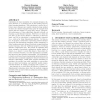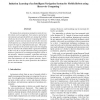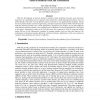169 search results - page 24 / 34 » Reductions among high dimensional proximity problems |
KDD
2006
ACM
14 years 8 months ago
2006
ACM
Calculation of object similarity, for example through a distance function, is a common part of data mining and machine learning algorithms. This calculation is crucial for efficie...
SBRN
2008
IEEE
14 years 1 months ago
2008
IEEE
The design of an autonomous navigation system for mobile robots can be a tough task. Noisy sensors, unstructured environments and unpredictability are among the problems which mus...
HICSS
2005
IEEE
14 years 1 months ago
2005
IEEE
Because today’s workforce is highly mobile, small wireless devices are being used to support mobile work collaboration. However, do computer platform differences affect such col...
CSDA
2008
13 years 7 months ago
2008
The computation of the Tukey depth, also called halfspace depth, is very demanding, even in low dimensional spaces, because it requires that all possible one-dimensional projectio...
JCIT
2010
13 years 2 months ago
2010
With the development of telecom business, customer churn prediction becomes more and more important. An outstanding issue in customer churn prediction is high dimensional problem....



